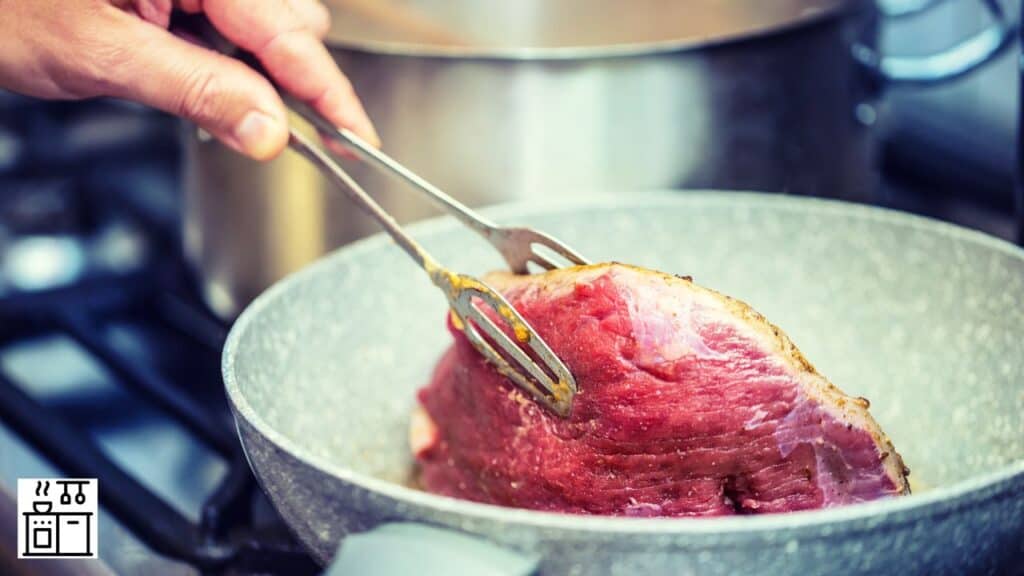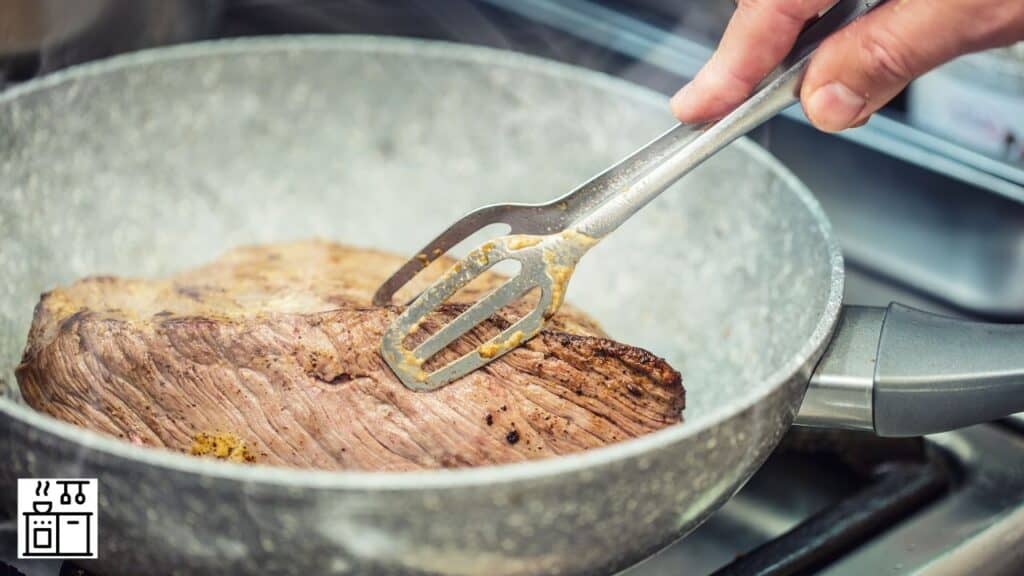Ceramic pans are some of the most beautiful cookware you will find in the market. They are versatile, and you can use them for a multitude of needs.
Though these pans are durable, a few precautions will help you maximize their lifespan.
Let’s look at how to cook with them to optimize their use.
- Cooking with Ceramic Pans Optimally
- 1. Clean the Pan Before Use
- 2. Lightly Season the Pan
- 3. Avoid Using Cooking Spray on The Pan Surface
- 4. Avoid the Use of Metal Utensils
- 5. Cook on Medium Heat
- 6. Wash only After the Pan Cools Down
- 7. Use Gentle Cleaners
- 8. Use Hot Water to Get Rid of Stubborn Food Residue
- 9. Tend to Stains and Discoloration Immediately
- 10. Wipe and Store the Pans Carefully After Use
Cooking with Ceramic Pans Optimally
Here are some good practices to follow while cooking with ceramic pans.
1. Clean the Pan Before Use
If you bought a new ceramic pan, we don’t recommend using it directly. You should clean the pan first.
Get rid of all the packaging and labels. Then, wash the pan with warm, soapy water. Washing it will remove any dust particles, glue, and chemicals on the surface.
If the pan has any sticky residue that doesn’t come off easily, soak it in warm soapy water.
This extra step will remove it completely and prevent you from ingesting any harmful substances.
2. Lightly Season the Pan
Ceramic pans don’t usually need any seasoning. The ceramic coating works differently.
When heated, it releases silicon oil that makes the surface non-stick. So food glides off easily.
However, certain variations of ceramic pans require light seasoning before the first use. Seasoning seals any gaps in the surface, making it even and non-stick.
The manufacturer will specify it on the label. After seasoning it for the first time, you may have to season it again after a few months.
To season a ceramic pan, clean it and apply one teaspoon of edible oil.
Then, place it on the stove or inside an oven for three minutes. Remove the pan from heat and let it cool.
Wipe off any excess oil and your pan is ready to use.
Further Reading: Can Ceramic Pans Go in The Oven?
3. Avoid Using Cooking Spray on The Pan Surface
Ceramic pans don’t need much oil for cooking. However, some variants perform best when you season them.
In any case, the non-stick layer of the pan will wear off over time. This reduces its non-stick properties.
So you will have to apply oil to the surface. You can use any edible oil, but we don’t recommend using cooking spray.
The cooking spray contains lecithin and other chemicals that wear down the non-stick layer.
Stick to regular edible oil or butter to ensure that there is no build-up and the pan lasts longer.
4. Avoid the Use of Metal Utensils
You can stir ingredients in cast iron and carbon steel pans using metal utensils. However, we don’t recommend using them on ceramic pans.
The surface of ceramic pans isn’t as rugged as carbon steel or cast iron. So metal utensils can cause abrasions.
These abrasions make the pan deteriorate and lose its non-stick properties. Use silicone or wooden utensils instead for stirring ingredients in a ceramic pan.
5. Cook on Medium Heat

Pure ceramic pans can withstand high temperatures because of the way they are constructed.
However, most of the ceramic pans in the market are not made of pure ceramic.
They have a metal base covered with layers of ceramic. These pans can’t withstand extreme temperatures like pure ceramic pans.
Low or medium heat is always recommended when cooking with ceramic cookware. The safe temperature range is 500°F.
Beyond this temperature, there is a risk of the ceramic coating being impacted. It may break down, and the pan can end up getting damaged.
To prevent this from happening, always use ceramic pans at medium or low temperatures in the oven or on the stovetop.
Also, avoid dry heating the pan as it can degrade the coating.
6. Wash only After the Pan Cools Down
The ceramic coating is vulnerable to sudden temperature changes.
This means that you shouldn’t suddenly heat the pan followed by cooling it. Doing so can warp the surface.
The effect will be more pronounced if the core is made of aluminum or stainless steel since these metals undergo drastic thermal expansion and cooling.
To safeguard the sensitive ceramic pan surface, wait for the pan to cool to room temperature for washing.
This will prevent thermal shock and allow the pan to retain its attractive characteristics.
7. Use Gentle Cleaners
Ceramic pans are generally easy to clean because of their non-stick properties. Food doesn’t stick to the surface.
So you can clean the pan using gentle non-abrasive cleaners. Warm soapy water is usually enough to get rid of any oily residue.
Avoid using harsh dishwashing liquids or abrasive cleaners to scrub the surface. They can scratch the ceramic coating and reduce its lifespan.
8. Use Hot Water to Get Rid of Stubborn Food Residue
Cleaning a ceramic pan doesn’t require elbow grease or harsh cleaning agents.
However, if you end up burning the food, the residue may not come off if you use just soapy water.
In this case, avoid using any abrasive cleaner or harsh dishwashing liquids.
When simple washing doesn’t work, soak the pan in warm soapy water for at least thirty minutes. This will dislodge the food.
After this, apply some baking soda and use a non-scratchy scrubber to clean the pan.
It will usually do the job unless the food has burnt and charred on the surface.
If this is the case, combine vinegar with warm water and place the pan on the stove on medium heat.
Allow it to boil gently. When water boils, it will detach the food from the pan surface. This will make it easier to wipe it away.
9. Tend to Stains and Discoloration Immediately
Ceramic pans are very attractive because of their iconic colors and beautiful surface finish.
However, their surfaces are prone to stains and discoloration. Cooking certain ingredients like tomatoes and beets will stain the white surface.
If you leave dishes containing these ingredients in the pan for too long, the stains settle. It will be difficult to clean later.
To keep ceramic pans looking good as new, tend to any stains immediately.
After cooking these ingredients, transfer the dish to a serving dish immediately and wash the pan before the stains set in.
You can also use lemon, vinegar, or baking soda during cleaning to prevent any stains from setting. However, these work only if the stain is fresh.
10. Wipe and Store the Pans Carefully After Use
Ceramic pans are sturdier than Teflon pans. But they are more fragile than stainless steel, cast iron, and carbon steel.
They can easily develop scratches, and the surface can chip away. The pans can also become misshapen and lose their surface coating with rough handling.
To extend the lifespan of ceramic non-stick pans, store them properly.
Clean the pans and put them away carefully. Don’t stack them up and use liners to protect the ceramic surface.
This will extend their lifespan and keep them in good working condition for much longer.

